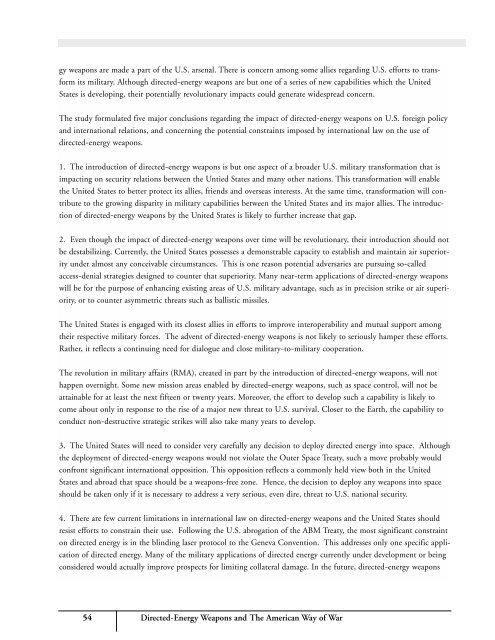directed-energy-weapons
directed-energy-weapons
directed-energy-weapons
Create successful ePaper yourself
Turn your PDF publications into a flip-book with our unique Google optimized e-Paper software.
gy <strong>weapons</strong> are made a part of the U.S. arsenal. There is concern among some allies regarding U.S. efforts to transformits military. Although <strong>directed</strong>-<strong>energy</strong> <strong>weapons</strong> are but one of a series of new capabilities which the UnitedStates is developing, their potentially revolutionary impacts could generate widespread concern.The study formulated five major conclusions regarding the impact of <strong>directed</strong>-<strong>energy</strong> <strong>weapons</strong> on U.S. foreign policyand international relations, and concerning the potential constraints imposed by international law on the use of<strong>directed</strong>-<strong>energy</strong> <strong>weapons</strong>.1. The introduction of <strong>directed</strong>-<strong>energy</strong> <strong>weapons</strong> is but one aspect of a broader U.S. military transformation that isimpacting on security relations between the Untied States and many other nations. This transformation will enablethe United States to better protect its allies, friends and overseas interests. At the same time, transformation will contributeto the growing disparity in military capabilities between the United States and its major allies. The introductionof <strong>directed</strong>-<strong>energy</strong> <strong>weapons</strong> by the United States is likely to further increase that gap.2. Even though the impact of <strong>directed</strong>-<strong>energy</strong> <strong>weapons</strong> over time will be revolutionary, their introduction should notbe destabilizing. Currently, the United States possesses a demonstrable capacity to establish and maintain air superiorityunder almost any conceivable circumstances. This is one reason potential adversaries are pursuing so-calledaccess-denial strategies designed to counter that superiority. Many near-term applications of <strong>directed</strong>-<strong>energy</strong> <strong>weapons</strong>will be for the purpose of enhancing existing areas of U.S. military advantage, such as in precision strike or air superiority,or to counter asymmetric threats such as ballistic missiles.The United States is engaged with its closest allies in efforts to improve interoperability and mutual support amongtheir respective military forces. The advent of <strong>directed</strong>-<strong>energy</strong> <strong>weapons</strong> is not likely to seriously hamper these efforts.Rather, it reflects a continuing need for dialogue and close military-to-military cooperation.The revolution in military affairs (RMA), created in part by the introduction of <strong>directed</strong>-<strong>energy</strong> <strong>weapons</strong>, will nothappen overnight. Some new mission areas enabled by <strong>directed</strong>-<strong>energy</strong> <strong>weapons</strong>, such as space control, will not beattainable for at least the next fifteen or twenty years. Moreover, the effort to develop such a capability is likely tocome about only in response to the rise of a major new threat to U.S. survival. Closer to the Earth, the capability toconduct non-destructive strategic strikes will also take many years to develop.3. The United States will need to consider very carefully any decision to deploy <strong>directed</strong> <strong>energy</strong> into space. Althoughthe deployment of <strong>directed</strong>-<strong>energy</strong> <strong>weapons</strong> would not violate the Outer Space Treaty, such a move probably wouldconfront significant international opposition. This opposition reflects a commonly held view both in the UnitedStates and abroad that space should be a <strong>weapons</strong>-free zone. Hence, the decision to deploy any <strong>weapons</strong> into spaceshould be taken only if it is necessary to address a very serious, even dire, threat to U.S. national security.4. There are few current limitations in international law on <strong>directed</strong>-<strong>energy</strong> <strong>weapons</strong> and the United States shouldresist efforts to constrain their use. Following the U.S. abrogation of the ABM Treaty, the most significant constrainton <strong>directed</strong> <strong>energy</strong> is in the blinding laser protocol to the Geneva Convention. This addresses only one specific applicationof <strong>directed</strong> <strong>energy</strong>. Many of the military applications of <strong>directed</strong> <strong>energy</strong> currently under development or beingconsidered would actually improve prospects for limiting collateral damage. In the future, <strong>directed</strong>-<strong>energy</strong> <strong>weapons</strong>54 Directed-Energy Weapons and The American Way of War


